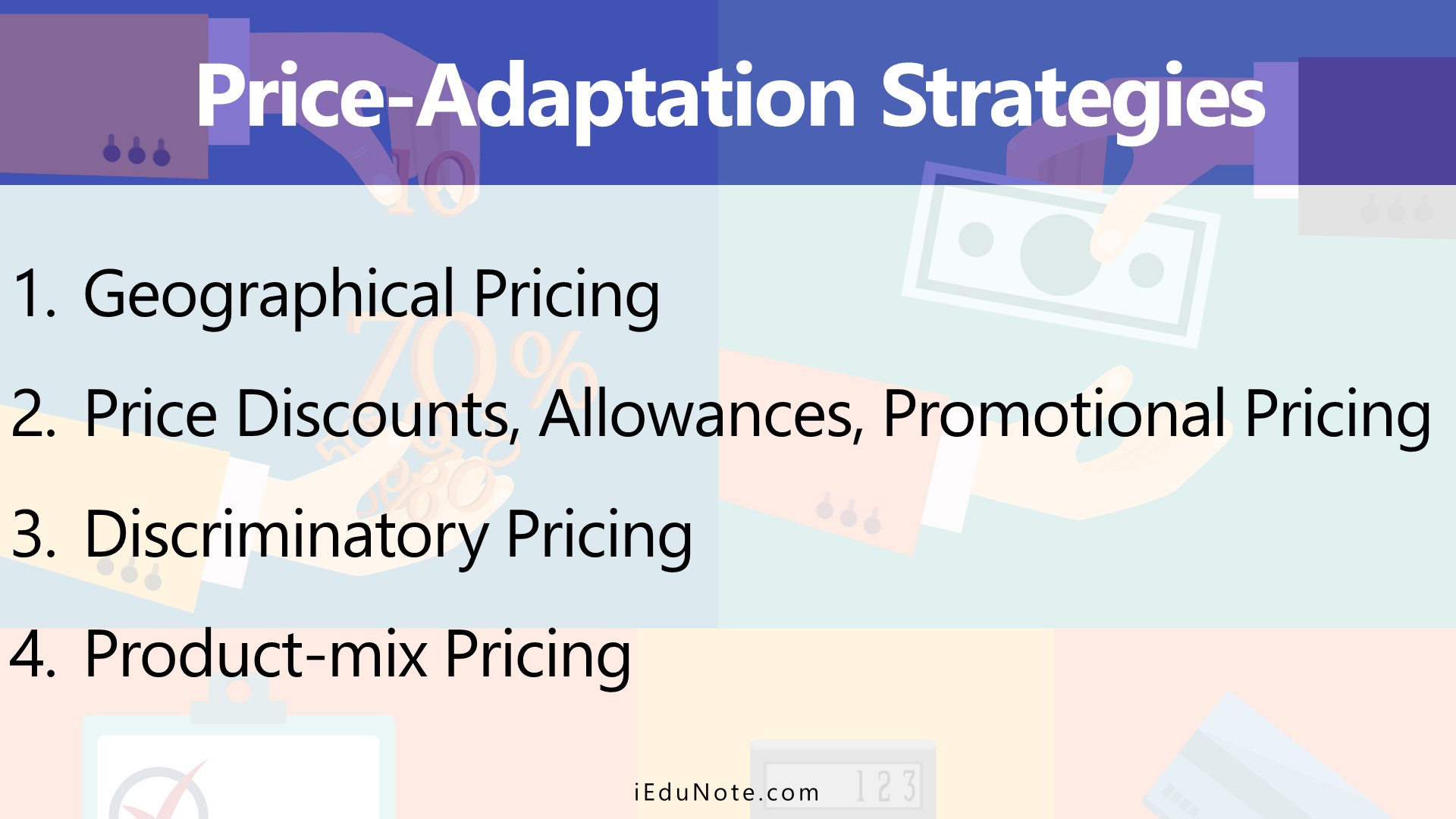What is Price Adaptation?
Prices set by a company do not always remain the same. Over time, the original price established for almost any product will have to be adjusted. The marketing executive will find it necessary to change the product’s price several times during the course of its life cycle.
They are changed or adapted depending on the needs or situations. A company needs to adapt its prices to different situations, i.e., it may charge different prices depending on geographic variation, variations in segments, purchase timing, order levels, delivery frequency, guarantees, service contracts, and some other factors.
Goals of Price Adaptation
Price adaptations are made to pursue a number of goals;
- change of purchase patterns;
- market segmentation;
- market expansion;
- utilization of excess capacity;
- implementation of channel strategy; and,
- to meet the competition.
Change of Purchase Patterns
Marketers may adapt their prices to influence or change patterns of purchase.
Lower prices may be granted to induce customers to buy in larger quantities, buy in anticipation of future needs, or concentrate their purchases among fewer supply sources.
Higher prices may be charged from certain customers to discourage them from carrying the line, thus reducing the intensity of competition in certain markets.
Market Segmentation
Marketers can also adapt their prices to tap segments of a market, which differ in demand elasticity.
These differences in sensitivity to price may come about because of differing values in use among various classes of buyers and/or differing competitive situations facing the seller.
Market Expansion
The market for a given product or service may be expanded by offering lower prices to customers who have lower values in use.
Such expansion may also be accomplished by offering lower prices to present customers to gain new product or service applications where prior price levels made such applications uneconomic.
Utilization of Excess Capacity
Price adaptations can also be made to utilize excess production or marketing capacity.
If such capacity exists, adaptation makes a sale possible, which covers direct costs and will contribute to the firm’s total profits.
Implementation of Channel Strategy
Price adaptation is a major device by which a firm attempts to implement its marketing strategy with regard to channels of distribution. Price variations may reflect differences in marketing tasks performed by various types of resellers or differences in the competitive environments in which they operate.
Adaptation may encourage certain channels to engage in the various promotion of the line or be used to represent the line in diverse channels.
To Meet Competition
Adaptation in price is also a device that can be used to meet competition.
The value sets the price ceiling for a given product or service in use or utility offered to the buyer as well as by the alternatives open to the buyer with respect to other sources of supply.
Where the seller is disadvantaged because production facilities are located far from the potential buyer, a price adaptation may be made to make the delivered price attractive compared to the competition.
Price Adaptation Strategies

The price of a company may be adapted following a number of adaptation strategies. A company may choose one or more of these strategies depending on the policies it decides to pursue.
Different price-adaptation strategies to be discussed here are;
- geographical pricing;
- price discounts, allowances, and promotional pricing;
- discriminatory pricing; and
- product-mix pricing.
1. Geographical Pricing
In addition to deciding what price to set for the product, a marketer may also have to decide whether to charge different prices in different geographic areas.
The basic issue confronting the executive here is recognizing that market conditions and consumer sensitivities to price vary by geographic area. The difference in price occurs not only on wide territorial bases but also between districts and even in different parts of the same district.
Though such an exercise is very costly, the executive could segment the overall market into tiny geographic areas and set unique prices in each.
In geographic pricing, a company may charge variable prices depending on the customers living at different locations or countries.
A company may charge a higher price to distant customers to cover higher shipping and other costs or even charge a lower price to increase sales. A company may follow different techniques with regard to realize the money.
They are;
- barter, compensation deal (receives some percentage in cash and rest in products),
- buyback arrangement (accepting partial payments through products manufactured by the buyer), and
- offset (receives full payments in cash but agrees to spend a substantial portion in that country or region in buying products produced there).
2. Price Discounts, Allowances, and Promotional Pricing
The standard price established for the product by a marketer is list price. But it is not always the actual price charged to the customer.
Here, basic prices are modified to reward customers for such acts as early payments, volume purchases, and off-season buying and called together discounts and allowances.
Marketers sometimes offer a discount or allowance to the buyers, effectively reducing the product’s list price, making it more competitive in the marketplace, stimulating short-term demand, or creating product awareness.
In order to attain any of these objectives, a marketer can choose from a variety of discount and allowance methods. Some of the most commonly used strategies are:
- Quantity discounts.
- Cash discounts.
- Trade discounts.
- Seasonal discounts.
- Promotional allowances – loss-leader pricing, special-event pricing, cash rebates, low-interest financing, longer payment terms, warranties and service contracts, psychological discounting.
- Forward dating.
- Other allowances.
Quantity Discounts
Here a marketer reduces the list price based on the number of units purchased.
It can be very effective at both consumer and middleman levels. This type of discount is allowed to buyers who buy in bulk volume. This discount again may vary with the quantity purchase.
A marketer can use two forms of quantity discounts, viz. noncumulative and cumulative. A noncumulative quantity discount applies to the number of units purchased in a single transaction at a single point in time.
For example, a “3 for $1.00” price is actually a quantity discount since the buyer will pay $0.50 for one unit, but $1.00 for three, a savings of $0.50. At the middleman level, the marketing executive will use a noncumulative discount.
Usually, larger purchases allow for economies of scale to process the orders and transport them to the middleman.
On the other hand, the cumulative discount reduces the price based on the number of units purchased within some time period.
Whether used at the consumer or middleman levels, its purpose is to encourage buyer loyalty to the seller rather than gain large purchase orders from them.
Cash Discounts
A cash discount is a reduction in the list price based on the buyer’s early payment in cash. However, it is not used extensively at the consumer level but is a widely adopted practice at the middleman level.
Its basic purpose is to stimulate rapid payment and draw in precious cash to the company. It is paid to customers who pay their bills promptly.
For example, “5/15, net 30” means a customer has to pay his bill within 30 days but will get a 5% discount if he pays within 15 days—the biggest problems in offering cash discounts center on the administrative burdens potential for abuse.
Some of the buyers may take the facility of discount but not pay within the stipulated time, causing financial trouble for the company.
Trade Discounts
Reducing the product’s list price to an intermediary is called a trade or functional discount. It is basically offered to the manufacturers’ channel members if they (channel members) perform certain functions such as selling, storing, and record keeping.
It may vary from channel member to channel member depending on the type and magnitude of functions performed by them.
Seasonal Discounts
Here the product’s list price is reduced in order to stimulate sales during a particular time period.
Such a discount may be given to the buyer to induce earlier than necessary purchases of seasonally used products or to build sales during traditionally off-peak periods. If a buyer buys a manufacturer’s product in the off-season, he may be offered a seasonal discount by the manufacturer.
This type of discount allows the seller to roll his product around the year due to which he can keep his production going on throughout the year.
Promotional Allowances
To encourage intermediaries to promote or otherwise display a product, a marketer can offer a promotional allowance. If the buyer allows a reduction on the list price to the seller, it can be termed as allowance.
To ensure dealers’ participation in advertising and sales support programs, sellers normally offer allowances.
In practice, this allowance can take one of several forms. Some of the commonly practiced ones are discussed below.
- Loss-Leader Pricing: More legitimate pricing techniques are known as loss-leader selling, whereby the price is set below invoice cost in order to reduce inventory size. To stimulate additional traffic to store, supermarkets and department stores normally drop the price on well- known brands. On the other hand, leader pricing is merely a reduction from the going price, also intended to reduce inventory.
- Special-Event Pricing: Special-event pricing involves advertised sales or price-cutting to increase revenue or lower costs. To attract more customers, sellers establish special prices in certain seasons, such as the beginning of the month or the beginning of the year. Special event pricing entails coordination of production, scheduling, storage, and physical distribution. Whenever there is a sales lag, a special sales event may be launched.
- Cash Rebates: To clear their inventories, manufacturers normally offer cash rebates if products are purchased within a specified time period.
- Low-Interest Financing: A company can offer low-interest financing to customers instead of cutting its product price and thus can increase sales.
- Longer Payment Terms: Here, buyers are offered the opportunity to buy the product in installments by charging a higher price of the product.
- Warranties and Service Contracts: By offering free or a reduced price warranty or service, a company can promote its sales.
Forward Dating
Such discounts are offered to intermediaries. The marketing executive will offer the products to the buyer and not charge for the goods until a later date.
For example, the product may be shipped to a buyer in December, but he won’t be billed until April. The advantage to buyers of this type of price offer is that they can have the products and possibly sell them before having to make the payment.
Thus, they do not tie up their funds in inventory. For the company, sales are guaranteed, and production can be scheduled more effectively.
Other Allowances
In addition to the above, marketers can also offer some other discounts to their customers. Some of them are discussed here. Rebates are cash refunds for buying the product.
They have been very popular at the consumer level. Trade-ins can also be used by the marketing executive to discount the product’s list price.
It is a price reduction given for used goods when similar new goods are bought. By giving fair market value, or even more on a trade-in, the executive can effectively change the actual price charged to the buyer.
Push money (PM) can sometimes be used by the marketer to support particular products’ sales. Push money is funds passed down to retail sales clerks to encourage them to emphasize the company’s product instead of his competitors’ ones.
3. Discriminatory Pricing
To accommodate differences in customers, products, locations, and so on, a company often modifies its basic price. Types of Discriminatory Pricing are;
- Customer-Segment Pricing.
- Product-Form Pricing.
- Image Pricing.
- Location Pricing.
- Time Pricing.
Customer-Segment Pricing
The same product may be sold at different prices to different customer groups though the production costs are the same. For example, students and freedom fighters may be charged half fare by transport companies.
Product-Form Pricing
The product of a company may have different versions or sizes. In such a situation, it may charge different prices for different versions or sizes but not proportionately with respect to the product’s cost.
Image Pricing
Based on image differences, the price of the same product may be fixed at different levels.
For example, a particular brand of one-liter soybean oil in the tetra pack maybe charge $45/-. The same quantity of the same brand in a glass bottle may be charged $70/- thus, the company is trying to develop two different images of the same product.
Location Pricing
Different prices may be charged for the same product sold in a different location (geographic or other) though the cost of offering the product is the same. For example, a cinema hall charges different prices for a front stall, rear stall, or other types of seats.
Time Pricing
If prices are varied by season, day, or hour, it may be termed as time pricing. Hotels, airlines, public utility companies such as DESA, T&T, etc. normally practice time pricing.
4. Product-Mix Pricing
The logic of setting or charging a price on an individual product has to be modified when the product is a member of a product mix.
Six situations may be distinguished involving product-mix pricing;
- product-line pricing,
- optional-feature pricing,
- captive-product pricing,
- two-part pricing,
- byproduct pricing, and
- product-bundling pricing.
Product-Line Pricing
If a company maintains a product line instead of a single product, it may set various prices for a single product in the line to develop different images in the minds of the buyer.
For example, an electronics company may carry 21 inches of color television at three price levels. Customers will thus associate three price levels with three types of quality.
Optional Feature Pricing
If a company offers optional products or features along with its main products, it can go for optional-feature pricing.
For example, a hotel can charge a low price for accommodation and charge high for car rental service being offered by it since guests require transport service in addition to accommodation facilities.
Captive-Product Pricing
There are some products that require ancillary or captive products to be used properly, such as a battery for battery-operated toys or films for cameras.
Producers of main products may charge high prices for the captive products and warning customers not to use ancillary products manufactured by other companies for guaranteed performance.
Two-Part Pricing
This type of pricing is practiced mostly by service firms. They charge a fixed price for the basic service and a variable usage fee for other services.
For example, a museum may charge a fixed entry fee and variable fees for seeing different objects or events. Normally the fixed fee is charged low to encourage the purchase of the basic fee, which in turn induce buyers to purchase other services.
Byproduct Pricing
Byproducts are sometimes an automatic outcome of the production of certain items such as petroleum from a paint manufacturing plant.
A company can price byproducts low to increase its revenue and support its main operation.
Product-Bundling Pricing
A seller may offer its bundle of products at a reduced price than the individual prices added together.
For example, a tool manufacturer may combine a number of tools together and price the bundle low compared to the individual gadgets’ total price. It will induce buyers to buy the bundle instead of buying a particular one or two items and thus saving money.

